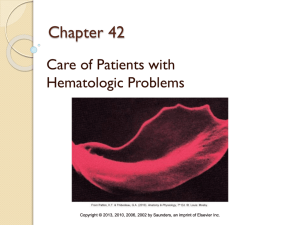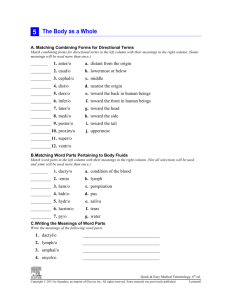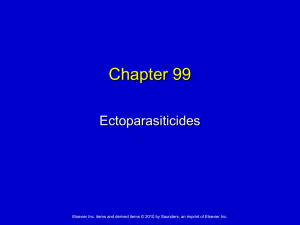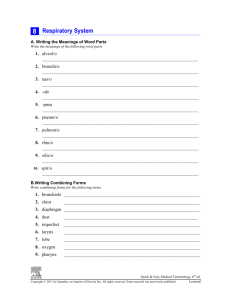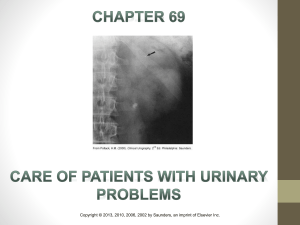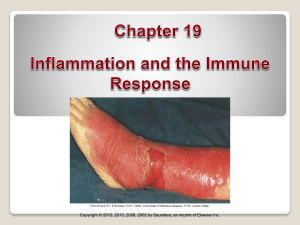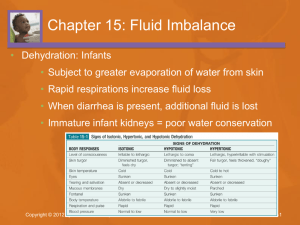Chapter 010
advertisement
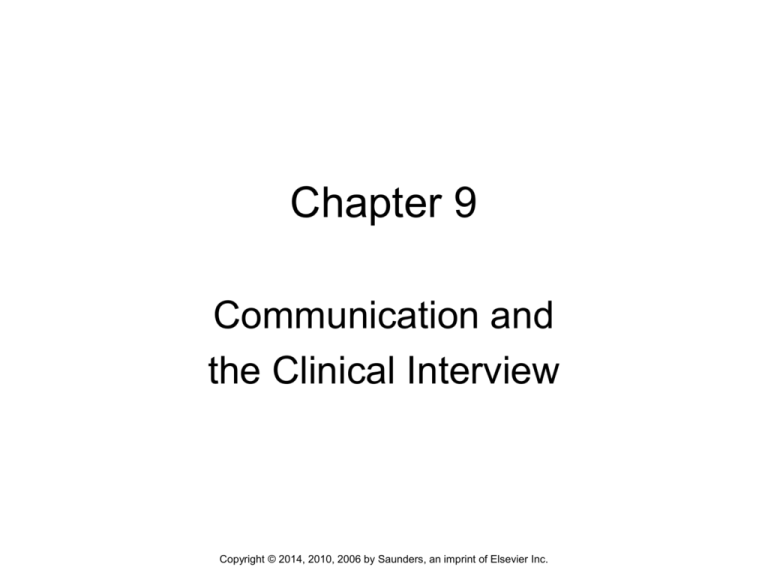
Chapter 9 Communication and the Clinical Interview Copyright © 2014, 2010, 2006 by Saunders, an imprint of Elsevier Inc. The Communication Process Stimulus for information, comfort, or advice Sender – Initiates contact Message – Sent or expressed Variety of media – Hearing, visual, touch, smell Feedback received Copyright © 2014, 2010, 2006 by Saunders, an imprint of Elsevier Inc. 2 Case Study A new nurse on a psychiatric unit wants to effectively communicate in a therapeutic relationship with a patient. What are some things that will help this communication? Copyright © 2014, 2010, 2006 by Saunders, an imprint of Elsevier Inc. 3 Factors That Affect Communication Personal factors Environmental factors Relationship factors Copyright © 2014, 2010, 2006 by Saunders, an imprint of Elsevier Inc. 4 Verbal Communication All words a person speaks Communicates Beliefs and values Perceptions and meaning Can convey Interest and understanding Insult and judgment Clear or conflicting messages Honest or distorted feelings Copyright © 2014, 2010, 2006 by Saunders, an imprint of Elsevier Inc. 5 Nonverbal Communication Tone of voice Emphasis on certain words Physical appearance Facial expressions Body posture Amount of eye contact Hand gestures Copyright © 2014, 2010, 2006 by Saunders, an imprint of Elsevier Inc. 6 Therapeutic Communication Techniques Tools for enhancing communication Using silence Active listening Listening with empathy Copyright © 2014, 2010, 2006 by Saunders, an imprint of Elsevier Inc. 7 Clarifying Techniques Paraphrasing Restating Reflecting Exploring Projective questions Presumption questions Copyright © 2014, 2010, 2006 by Saunders, an imprint of Elsevier Inc. 8 Asking Questions and Eliciting Patient Responses Open-ended questions Closed-ended questions Copyright © 2014, 2010, 2006 by Saunders, an imprint of Elsevier Inc. 9 Nontherapeutic Communication Techniques Excessive questioning Giving approval or disapproval Giving advice Asking “why” questions Copyright © 2014, 2010, 2006 by Saunders, an imprint of Elsevier Inc. 10 Cultural Considerations Communication style Eye contact Touch Cultural filters – Form of bias or prejudice Copyright © 2014, 2010, 2006 by Saunders, an imprint of Elsevier Inc. 11 Preparing for the Interview Pace Setting Seating Introductions Initiating the interview Copyright © 2014, 2010, 2006 by Saunders, an imprint of Elsevier Inc. 12 Attending Behaviors Foundation of the interview Eye contact Body language Vocal quality Verbal tracking Copyright © 2014, 2010, 2006 by Saunders, an imprint of Elsevier Inc. 13 Clinical Supervision Communication and interviewing are acquired skills Fosters professional growth and helps minimize the development of nontherapeutic nurse-patient relationships. Copyright © 2014, 2010, 2006 by Saunders, an imprint of Elsevier Inc. 14 Process Recording Written record of a segment of the nurse-patient session that reflects as closely as possible the verbal and nonverbal behaviors of both patient and nurse Useful tool for identifying communication patterns Copyright © 2014, 2010, 2006 by Saunders, an imprint of Elsevier Inc. 15 Audience Response Questions 1. As a nurse assesses a new client, the nurse makes sure the door remains open. Which type of communication factor is this action? A. Environmental B. Relationship C. Personal Copyright © 2014, 2010, 2006 by Saunders, an imprint of Elsevier Inc. 16 Audience Response Questions 2. A nurse assesses a newly hospitalized client. Which communication technique will the nurse use most? A. Rapid, high-pitch voice tone B. Closed-ended questions C. Direct eye contact D. Frequent touch Copyright © 2014, 2010, 2006 by Saunders, an imprint of Elsevier Inc. 17



